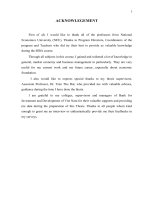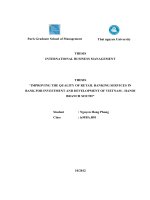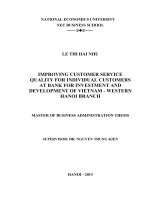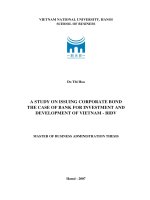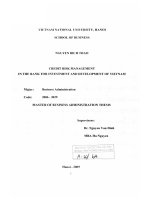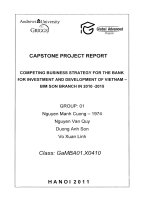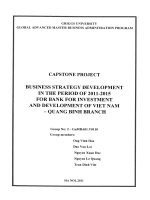Research on customer satisfaction for non credit services in joint stock comercial bank for investment and development of viet nam, hoan kiem branch
Bạn đang xem bản rút gọn của tài liệu. Xem và tải ngay bản đầy đủ của tài liệu tại đây (1.99 MB, 98 trang )
ĐẠI HỌC QUỐC GIA HÀ NỘI
KHOA QUẢN TRỊ VÀ KINH DOANH
---------------------
HÀ QUỐC DŨNG
RESEARCH ON CUSTOMER SATISFACTION FOR NON-CREDIT
SERVICES IN JOINT STOCK COMERCIAL BANK FOR INVESTMENR
AND DEVELOPMENT OF VIETNAM, HOAN KIEM BRANCH
NGHIÊN CỨU SỰ HÀI LÒNG CỦA KHÁCH HÀNG ĐỐI VỚI DỊCH
VỤ PHI TÍN DỤNG TẠI NGÂN HÀNG TMCP ĐẦU TƯ VÀ PHÁT
TRIỂN VIỆT NAM - CHI NHÁNH HOÀN KIẾM
LUẬN VĂN THẠC SĨ QUẢN TRỊ KINH DOANH
HÀ NỘI - 2018
ĐẠI HỌC QUỐC GIA HÀ NỘI
KHOA QUẢN TRỊ VÀ KINH DOANH
---------------------
HÀ QUỐC DŨNG
RESEARCH ON CUSTOMER SATISFACTION FOR NON-CREDIT
SERVICES IN JOINT STOCK COMERCIAL BANK FOR INVESTMENR
AND DEVELOPMENT OF VIETNAM, HOAN KIEM BRANCH
NGHIÊN CỨU SỰ HÀI LÒNG CỦA KHÁCH HÀNG ĐỐI VỚI DỊCH VỤ
PHI TÍN DỤNG TẠI NGÂN HÀNG TMCP ĐẦU TƯ VÀ PHÁT TRIỂN
VIỆT NAM - CHI NHÁNH HOÀN KIẾM
Chuyên ngành: Quản trị kinh doanh
Mã số: 60 34 01 02
LUẬN VĂN THẠC SĨ QUẢN TRỊ KINH DOANH
NGƯỜI HƯỚNG DẪN KHOA HỌC: TS. PHẠM VĂN HỒNG
Hà Nội - 2018
DECLARATION
The author confirms that the research outcome in the thesis is the result of
author‟s independent work during study and research period and it is not yet published
in other‟s research and article.
The other‟s research result and documentation (extraction, table, figure,
formula, and other document) used in the thesis are cited properly and the permission
(if required) is given.
The author is responsible in front of the Thesis Assessment Committee, Hanoi
School of Business and Management, and the laws for above-mentioned declaration.
Date ..…./01/2018
i
ACKNOWLEDGEMENT
“During the process of fulfilling this master‟s thesis, I have received many necessary
assistances. First of all, I would like to express my sincere thanks to Mr. Hong Pham
Van. PhD, the supervisor of this research, who has created favorable conditions,
instructed and helped enthusiastically as well as responsibly to me during the thesis.
Secondly, I also appreciate the teachers in Hanoi School Of Business And
Management – Vietnam National University, the scientists, the authors of scientific
papers helping me complete this essay.
ii
TABLE OF CONTENTS
TABLE OF CONTENTS.......................................................................................................................1
LIST OF TABLES ............................................................................................................................... vi
LIST OF FIGURES AND CHARTS ................................................................................................. vii
INTRODUCTION ..................................................................................................................................1
1. Rationale ................................................................................................................................. 1
2. Overview of research situation ............................................................................................... 2
3. Objectives of the research....................................................................................................... 5
3.1 General objective .................................................................................................................. 5
3.2 Specific objectives ................................................................................................................ 5
4. Objects of the research ........................................................................................................... 5
5. Scope of the research .............................................................................................................. 6
6. Methods of the research .......................................................................................................... 6
6.1 Information collection method ............................................................................................. 6
6.2 Information processing method ............................................................................................ 6
6.3 Other research methods ........................................................................................................ 7
7. Structure of the research ......................................................................................................... 7
CHAPTER
1:
OVERVIEW
OF
NON-CREDIT
SERVICES
AND
CUSTOMER
SATISFACTION WITH NON-CREDIT SERVICES AT COMMERCIAL BANKS. ...................8
1.1 Overview of non-credit services ........................................................................................... 8
1.1.1 Definition ........................................................................................................................... 8
1.1.2 Characteristics of non-credit services ................................................................................ 9
1.1.3 Types of non-credit services ............................................................................................ 10
1.2 Non-credit service quality and customer satisfaction ......................................................... 16
1.2.1 Definition of non-credit service quality........................................................................... 16
1.2.2 Neccessity of improving quality of non-credit services .................................................. 17
1.2.3 Definition of customer satisfaction.................................................................................. 20
1.2.4 Relationship between quality of non-credit services and customer satisfaction ............. 21
1.3 Some models of researches on customer satisfaction with quality .................................... 22
1.3.1 Research model of Parasuraman et al., ............................................................................ 22
1.3.2 Research model on customer of the authors of Can Tho University ............................... 23
iii
1.3.3 Research model of the author Mwatsika (2014) .............................................................. 24
1.3.4 Results of interviews with experts and proposed models of the thesis. .......................... 24
1.4 Experiences of some banks on improving customer satisfaction with the quality of noncredit service of the banks ........................................................................................................ 25
CHAPTER 2: ASSESS CUSTOMER SATISFACTION WITH QUALITY OF NON-CREDIT
SERVICES AT BIDV – HOAN KIEM BRANCH .......................................................................... 28
2.1 Introduciton of BIDV – Hoan Kiem Branch ...................................................................... 28
2.1.1 History of foundation and development ......................................................................... 28
2.1.2 Organization structure ..................................................................................................... 28
2.1.3 Business operation results ............................................................................................... 29
2.1.4 Result of non-credit service implementation at BIDV - Hoan Kiem Branch .................. 31
2.2 Result of survey on customer satisfaction with non-credit service at BIDV, Hoan Kiem
Branch ....................................................................................................................................... 35
2.2.1 Analyze characteristics of survey subjects ...................................................................... 35
2.2.2 Scale test .......................................................................................................................... 37
2.2.3 Exploratory factor analysis .............................................................................................. 38
2.2.4 Correlation analysis ......................................................................................................... 41
2.2.5 Regression analysis.......................................................................................................... 42
2.2.6 Customers‟ evaluation of the services of the Branch ...................................................... 43
2.3 Assess the quality of non-credit services at BIDV-Hoan Kiem branch ............................. 52
2.3.1 Achieved results .............................................................................................................. 52
2.3.2 Limitations and Causes .................................................................................................... 53
CHAPTER 3: PROPOSE SOLUTIONS TO IMPROVE THE CUSTOMER SATISFACTION
WITH THE QUALITY OF NON CREDIT SERVICES AT BIDV - HOAN KIEM BRANCH 55
3.1 Orientation for development of non-credit services at BIDV - Hoan Kiem branch........... 55
3.2 Solutions to improve customer satisfaction with the quality of non-credit services at BIDV
- Hoan Kiem Branch ................................................................................................................. 57
3.2.1 Solutions to improve the reliability of customers ............................................................ 57
3.2.2 Solution on non-credit service price ................................................................................ 57
3.2.3 Solutions to improve service capacity ............................................................................. 58
3.2.4 Solutions to enhance empathy ......................................................................................... 59
3.2.5 Solutions to enhance tangibles. ....................................................................................... 60
iv
3.2.6 Diversife solutions for Non-Credit Services ................................................................... 61
CONCLUSION ................................................................................................................................... 63
LIST OF REFERENCES .................................................................................................................... 65
APPENDIX .......................................................................................................................................... 67
Appendix 01: CUSTOMER SURVEY FORM ........................................................................ 67
Appendix 02: The results of data analysis ................................................................................ 70
v
LIST OF TABLES
Table 2.1: Represents business operation results of BIDV – Hoan Kiem Branch ............. 29
Table 2.2: Revenue of main non-credit services of BIDV - Hoan Kiem Branch ................. 32
Table 2.3: Struture of revenue – expense from non-credit service of BIDV Hoan Kiem .. 34
Table 2.4: Statistics describing the characteristics of respondents....................................... 35
Table 2.5: Results of the scale test ......................................................................................... 38
Table 2.6: Results of testing factor analysis for independent variables ............................... 38
Table 2.7: Results of testing factor analysis for dependent variables .................................. 40
Table 2.8: Correlation matrix among factors......................................................................... 41
Table 2.9: Results of regression analysis ............................................................................... 42
Table 2.10: Evaluation of trust ............................................................................................... 43
Table 2.11: About price of service ......................................................................................... 45
Table 2.12: Serving capability................................................................................................ 46
Table 2.13: Empathy ............................................................................................................... 48
Table 2.14: Tangibles .............................................................................................................. 49
Table 2.15: Service abundance ............................................................................................... 51
Table 2.16: Customer satisfaction .......................................................................................... 52
vi
LIST OF FIGURES AND CHARTS
Figure 1.1 Research of Parasuraman & ctg (1988) ............................................................... 22
Figure 1.2 Research of the authors of Can Tho University .................................................. 23
Figure 1.3 Research of Mwatsika (2014) .............................................................................. 24
Figure 1.4: The proposed research model.............................................................................. 25
vii
INTRODUCTION
1. Rationale
In the process of integration into the regional and world economy as well as in
the fierce competition environment of the banking industry, customer is the decisive
factor in the existence of the Banks. Those who win the interest and loyalty of
customers will be the winner and develop well. Operation towards customers is
becoming one of the most important business strategies. Collaborating with customers
in business, attracting new customers, consolidating current customers are becoming
an effective business tools with low cost but high business efficiency. How to offer
customers the best satisfaction is always the common target that almost banks try their
best to achieve.
Therefore, from 2006 up to now, the Commercial Banks have been in the race to
continuously upgrade their services with positive activities aiming at maximizing
customer satisfaction such as increasing capital, expanding business network,
diversifying products and services, equipping new technologies to provide modern
banking services ... And among above solutions, improving the quality of banking
services is the most important one,which attracting much attention.
Following general trend of the Industry, the Bank for Investment and
Development of Vietnam - BIDV is well aware of the importance of service quality in
the bank development. In which, Management side of the Bank pays the most attention
to the quality of non-credit services as this is main income of almost commercial banks
in general and BIDV in particular. Meanwhile, risks from non-credit servicesare lower
than credit services of the bank. Thus, besides raising the financial capacity,
diversifying types of services, expanding the network to dominate the market, BIDV
also focuses on improving the quality of non-credit services. To do this well, the Bank
must conduct research to find out the components building up the quality of non-credit
services through customers‟ expectation and perception.
That is the reason why the author decides to choose the topic: “Research
Customer Satisfaction with Non-Credit Services at Bank for Investment and
Development of Vietnam - Hoan Kiem Branch” as a thesis topic, so as to help the
1
Bankers get a better view of the quality of their non-credit services and since then find
out specific strategiesfor improving the service quality, bringing maximum satisfaction
to customers.
2. Overview of research situation
Currently, there are many researches on the quality of banking services and
customer satisfaction with each type of service. However, each type of service shall
have its own characteristics and specialization. Thus, it is inappropriate to apply
research result of new service for the other ones of the commercial banks.
The follows are some researches among many researches on non-credit services
and customer satisfaction with each type of service:
+ Parasuraman & et al. (1988) developed “SERVQUAL: A Multiple Item Scale
for Measuring Consumer Perceptions of Service Quality”. In their research, the
authors developed the SERVQUAL service quality assessment model. The model is
five-quality gap in which service quality is function of the fifth gap. This fifth gap
depends on the previous gap, the 1st, 2nd,3rd and 4th gaps. Therefore, to shorten the
fifth gap and increase the quality of service, the service manager must try to shorten
these distances. This research of Parasuraman et al. provides an extremely valuable
insight into service quality measurement and is a premise for further researches.
However, the factors in the model given by the authors only measure the quality
services generally and needs modifying in order to be more suitable with measuring
the non-credit service quality of the bank.
+ Research „„Asess customer satisfaction for service quality of payment card at
VietinBank - Can Tho Branch” by the authors in Can Tho University (2014). The
survey was conducted on 186 customers of Vietin Bank - Can Tho Branch. The
analytical methods being applied in the research were: Cronbach‟s alpha, Exploratory
Factor Analysis (EFA). Binary logistic model was used to test the relation between the
influence factors and customer satisfaction on the quality of payment card service at
VietinBank Can Tho branch. The research result showed that customer satisfaction
was established on the basis of the positive correlation with the factors such as
"serving manner", "trust" and "tangible means". The reaseach has provided VietinBank
2
Can Tho Branch the basis to implement appropriate solutions to improve the quality of
card services of the bank to meet the satisfaction of customers who use card servicesat
the branches of VietinBank in the future.
However, doing business on payment card service is only one of the activities
being included in the non-credit services of the Bank. The non-credit services not only
include payment card service but also many other services such as remittance, payroll,
Sec, etc...
Therefore, the mode of payment card service quality cannot be applied for the
research on customer satisfaction with non-credit service quality of the bank.
+ Research of Do Tien Hoa (2007) in the project: “Research Enterprise Customer
satisfaction with the products, services of HSBC Bank”. In his research, the author
based on operation status and development strategy of HSBC Bank to determine
customer expectation with the Bank; built the research model to measure customer
satisfaction based on studying the factors affecting customer satisfaction; assessed
customer satisfaction with the products and services of the Bank; suggested some
solutions to improve customer satisfaction with the products and services of the Bank.
Result of the research is the basis for the deployment of new products and services
meeting customers‟ demand and at the same time help implement the development
strategy assigned by the Management side of HSBC Bank: "All for the satisfaction of
customers". However, the research subject of the author is customer satisfaction with
all the service products offered by the Bank so it is inappropriate to apply the result of
this research for the non-credit services.
+ Research of Mwatsika (2014) on customer satisfaction with ATM card quality
at Malawi Bank in: “Customer satisfaction with ATM banking in Malawi”. To conduct
the research, the author interviewed the customers using QTM card at Malawi. Result
of the research showed five dimensions that affect customer satisfaction with the
quality service of ATM card such as: Reliability; Responsiveness; Empathy;
Assurance; Tangibles. However, due to the limited scale of samples (only 190
samples), the result of the research is not really reliable.
3
+ Mai Thi Hong Nhung (2011) developed the project: “Analysis of Customer
Satisfaction with non-credit services of Sai Gon Joint Stock Commercial Bank, Dong
Thap Branch”. In her research, the author achieved specific targets as follows:
Analysis of business activities of Sai Gon Joint Stock Commercial Bank, Dong
Thap Branch
Analysis of actual business activities of Sai Gon Joint Stock Commercial Bank,
Dong Thap Branch
Analysis of customer satisfaction with non-credit services of Sai Gon Joint Stock
Commercial Bank, Dong Thap Branch
Beside above achieved targets, the research did not build up the quality
assessment model of non-credit services. Masukujjaman and Afiaakter (2010) in the
project “Quality of Categorized Service and Customer Satisfaction in Banking
Industry: An Empirical Study on Private Commercial Banks in Bangladesh”. The
research has achieved specific targets such as:
- Identify service quality, customer satisfaction with the Bank‟s services such as
credit and foreign exchange services offered by private commercial banks in
Bangladesh.
- Distinguish the best services based on service quality of the private commercial
banks.
- Rank the decisive factors of service quality and customer satisfaction.
- Suggest the solution to improve service quality based on the analysis result of
the research.
Although the research has achieved the targets set initially, the research has not
called out the achievements and limits of service quality in the private commercial
Banks in Bangladesh, from which it suggests the solution
+ Research of Taikoo Change et al. (2013) on “Effects of Service Quality on
Customer Satisfaction in Banking Industry”. To conduct the research, the authors
delivered questionnaires to 150 customers using non-credit services at the commercial
banks. After that, the group used SPSS method to process collected data and from
4
which, suggested the solutions to improve customer satisfaction with service quality of
the banking industry.
However, since the subject of the research is quite wide “customer satisfaction
with service quality in banking industry” while each bank has its own specific
characteristics with the same given criteria, customers can satisfy with this bank but
another. Therefore, the sample model developed by the group does not assure accuracy
and reliability.
Thus, up to now, the author has not seen a comprehensive research on customer
satisfaction with service quality of non-credit services at commercial Banks in
Vietnam, especially BIDV, Hoan Kiem Branch. Therefore, this project shall have
different points in compared with the previous researches and fill the gaps of the
previous researches.
3. Objectives of the research
3.1 General objective
Study customer satisfaction with non-credit service quality at BIDV - Hoan Kiem
Branch in order to suggest the best solution to improve non-credit service quality for
the maximum satisfaction of the customers.
3.2 Specific objectives
- Systematization of theoretical background on non-credit services of the banks
and research model for customer satisfaction with non-credit service quality at
commercial banks
- Study customer satisfaction with non-credit service quality at BIDV - Hoan
Kiem Branch, from which,offer assessment of the achievement as well as limits in
service quality of the bank to suggest specific solutions.
- Suggest solution and recommendation in order to improve customer satisfaction
with non-credit service quality of BIDV - Hoan Kiem Branch.
4. Objects of the research
Customer satisfaction with non-credit service quality of BIDV - Hoan Kiem
Branch
5
5. Scope of the research
About space:
+ The research was conducted at BIDV - Hoan Kiem Branch
About time:
+ The research was conducted in the period from 2014-2016
About content: The research focused on actual business activities of non-credit
service and surveyed customer satisfaction with non-credit services at BIDV - Hoan
Kiem Branch
6. Methods of the research
6.1 Information collection method
To conduct the research, the author collected secondary and primary information.
Secondary information is the information directly related to actual business
activities of the non-credit services of the bank, including: Business result of noncredit services, numbers of non-credit products, sales of each non-credit service
product, etc... The secondary information was directly collected from BIDV - Hoan
Kiem branch in the period from 2014-2016.
Primary information: The primary information was collected by delivering
survey questionnaires, interviewing customers using non-credit service products of
BIDV - Hoan Kiem brach. To conduct the interview, the author got the information
about customers using non-credit services at the branch and asked the customers to
share the target of the survey and send customers the questionnaires via email .The
numbers of conducted samplesare 244.
6.2 Information processing method
Since this thesis used both secondary and primary information, the collected
information shall be processed according to two methods as follows:
+ With the secondary information, after collecting, the author processed data and
calculate figures with Microsoft Excel file. The result after being processed with Excel
file shall be used to analyze the business activities of non-credit servicesat BIDV Hoan Kiem branch.
6
+ With the primary information, after collecting, the author processed data with
SPSS 20.0 software. The collected data was processed with SPSS to check the
reliability. Result of the processed data shall show customer satisfaction with noncredit services of BIDV - Hoan Kiem branch.
6.3 Other research methods
- Analytical and synthesis methods: Based on the collected data and information,
the author shall analyze, evaluate and summarize to give out scientific conclusion and
proposals suitable with the theory and practice of customer satisfaction with non-credit
services.
- Expert method: The expert method was used to identify the factors that affect
customer satisfaction with non-credit services at BIDV - Hoan Kiem branch. The
experts were management members of the Bank and the staffs working in the noncredit field of the Bank.
7. Structure of the research
The thesis includes 3 chapters with the structure as follows:
Chapter 1: Overview of non-credit service and customer satisfaction with noncredit service at commercial bank.
Chapter 2: Evaluate customer satisfaction with non-credit services at BIDV Hoan Kiem branch
Chapter 3: Suggest solution to improve customer satisfaction with non-credit
service quality at BIDV - Hoan Kiem Branch
7
CHAPTER 1: OVERVIEW OF NON-CREDIT SERVICES AND CUSTOMER
SATISFACTION WITH NON-CREDIT SERVICES AT COMMERCIAL BANKS
1.1 Overview of non-credit services
1.1.1 Definition
+ Banking services
The Law on Credit Institutions of Vietnam (2010) has not yet come up with a
specific concept or explanation for the concept of banking services but only the term
"banking operations" mentioned in paragraph 12, article 4: "Business, regular supply
of one or several of the following operations: receipt of deposits; credit extension;
providing payment services via account". However, which one is the currency business
and which one is banking services is still not clear. This is one of the shortcomings of
the Law on Credit Institutions of Vietnam.
In his book named “Commercial bank management”, Peter S.Rose wrote: “Bank is
one kind of financial organization providing a list of the most diversity financial service,
especially credit, saving, payment services and operating the most financial function in
compared with other business organization in the economy”. “All the banks operate with
3 basic activities, which are capital mobilization, capital using activity and other
activities such as payment, budget”, he explained. (Peter S.Rose, 2001)
So banking services can be understood by two aspects:
Firstly, in a broad sense, banking services include all monetary, credit, payment,
foreign exchange activities of the banking system. This understanding is consistent
with the differentiation of banking services in the financial services of WHO and the
US-Vietnam FTA, as well as the classification of many developed countries.
Secondly, in the narrow sense, banking services only include non-monetary
business activities and banking operations according to financial intermediary function
(deposits, loans mobilization) – According to that, banking services only include offbalance sheet, fee charging activities such as money transfer, foreign exchange
business guarantee, international payment.
+ Non-credit services
8
In traditional service business activities of Commercial Banks, non-credit services
with payment activities are the most typical activities in which cash and non-cash
payment are the most typical. This is also the basis for commercial banks to raise capital
through the form of depositing money into banks with increasing utility. Almost other
non-credit services of commercial banks aim to increase the utility of the service and
efficiently use the income of customers through non-credit services day by day.
Non-credit services can be generated simultaneously with the operation of credit
services (capital mobilization and capital supply) of commercial banks in order to meet
the demand on deposits and loans of customers as desired. In addition, some noncredit services operate independently of credit operations such as recovering the
consumption amount of products for customers; payment for input factors of the
production process; payment of salary through accounts; transferring tax payments to
customers ... through services such as ATM cards; Cheque; money transfer.
Following factors can be used to recognize the banks using non-credit services:
Firstly, when making a transaction with customers, the bank does not have to use
capital (or little of capital being used if any) for the transaction.
Secondly, when making a transaction with the bank, customer must pay fee to
use the services provided by the bank. Income of the bank is now counted under fee
without interest and interest payment (interest rate) as credit services.
From such analysis, the author would like to give views on non-credit services as
follows: “Non-credit services are the services provided by the bank to meet customer
demands on finance, monetary in order to directly or indirectly bring the bank an
income equaling the fees which are identified to be collected from customers, not
including credit services”
1.1.2 Characteristics of non-credit services
In addition to general characteristics of banking services (intangibility,
insecurity, volatility, airworthiness), non-credit services also have following
characteristics:
- Beside initial capital investment for technology facility and human resources
fee, when making non-credit service transaction, commercial banks do not use or use
9
little of initial capital to perform its obligation right when implementing the contract.
This is one of the advantages that the banks should exploit to develop non-credit
services.
- The non-credit services might bring high profit to the commercial banks since
the transaction fee is usually low while the bank just mainly make use of its available
technology facility.
- The non-credit services of commercial banks are classified into relatively safe
business areas with low risk. Thus, expanding non-credit services will help
commercial banks limit risks such as interest rate risk, especially credit risk.
- The non-credit services of commercial banks are highly supportive and
interlinked. The services are always required to come together, the existence and
development of this service is associated with the others. Therefore, the bank's noncredit services require uniform development.
- The non-credit services are extremely diverse dand constantly developed.
Currently, there are many types of non-credit services in the world. With each type of
service, the banks give diversity supply method accordingly.
- There are many types of non-credit services being started and developed with
the support of information technology. Customers do not need to go to the bank but
they can carry out transactions through modern channels such as E-Banking, Home
Banking, etc... at home
1.1.3 Types of non-credit services
1.1.3.1. Traditional non-credit products
+ Payment service
Payment service plays an important role in the operation of commercial banks,
creating good condition for the development of many other banking services and is a
basis for the non-cash payment in the economy. Looking at the payment system of a
bank, one can assess the level and operation scale of that bank. There are the following
types of payment services:
* Domestic remittance payment:
10
Remittance payment is a banking service in which a bank transfers money to
another bank per request of individuals, organization or banks by withdrawing money
from customer‟s account according to request crediting to the beneficiary of the
account holder. After completion of payment services for customers, the bank collects
a certain fee. In order to perform payment requests of customers, the banks use noncash payment methods and instruments.
Payment methods include: Intra-bank payment; Payment between branches
within the same system; Interbank and Treasury interventions within the region and
country.
Non-cash payment instruments include: Cheque; Payment authorization;
Collection orders; Payment card...
* International remittance payment
International payment is the payment of monetary obligations and requirements
arising from economic, financial and credit relations among international economic
organizations, firms and among individuals of the various countries to end a cycle of
activities in the field of foreign economics by money transfers or clearing accounts.
Unlike domestic payment within a country, international payment is usually associated
with the conversion of the currency of the country to the currency of another country.
Main methods of international remittance include: Telegraphic Transfer;
Collection of payment; Letter of Credit; Open account; Payment via overseas accounts
...
The major international payment instruments are: Bill of Exchange; Money
order; Cheque
* International remittance payment:
International remittance is payment of monetary obligations and request arising
from economic, financial, credit relations among the international ecomnomic
organizations, firms, individuals of the different countries to complete an operation
cycle in the field of foreign trade through money transfer or clear accounts. Unlike
domestic payment, international payment is usually associated with currency exchange
between this country and another one.
11
There are main international remittance payment methods as follows:
Telegraphic transfer; Payment for collection; Letter of Credit; Open account; Payment
for oversea account, etc…
Main instruments of international payment are bill of exchange; promissory
notes; cheque
+ Other traditional non-credit services
* Conservation and consignment services
The bank stores stocks, investment fund certificates, insurance contracts,
property certificates, testaments and other valuables. These can be stored in an "open"
mean with an attached receipt detailing what is stored or is in "closed" mode, which
means being stored in closed boxes or sealed envelopes.
* Management and trust services
To conduct this service, the bank shall follow customer mandate such as making
investment trust, being executor in certain cases or managing property and making
payment for the beneficiaries at the appropriate time.
1.1.3.2. Traditional non-credit products
Supply modern payment modes
- ATM, Cash card
ATM cards are issued on the basis of a bank deposit, which is used to withdraw
cash at ATMs.
Cash cards are plastic cards with a certain amount of money on the card, which
shall be deducted directly on the card when buying goods or services.
- Cheque Cards are usually issued for customers whose current account is at least
18 years old to withdraw cash at banks and to secure payment for goods and services.
Domestic Cheque cards are only available for domestic withdrawals. When using this
card at another bank, the customers must pay an additional fee provided that the banks
must communicate with each other.
- Debit Card is issued by a bank for customers to pay for goods and services.
Card users must have a current account or deposit account and must have a balance at
the bank issuing the card. Customers can use the card for payment of goods and
12
services at any place where bank card reader of that bank is available without going
directly to the bank. When using the card for payment, the cardholder's account will be
immediately debited and the accounts of the sellers of the goods or services will be
credited through the automatic computer. Debit cards have some brands such as VISA,
Master Card, ACB, Success (VBARD), Connect 24 (VCB), Multi Card (Dong A
Bank) ...
- Credit Card are considered as bank cards as they are usually issued by the
banks. The bank will set a certain credit limit for each cardholder and cardholder can
only use within that limit until the payment due date to the banks. The basis of using
credit cards is to issue a bank loan. Credit card have some brands such as VISA,
Master Card ...
- Travel and Entertainment Card – T&E Card: Users of this card do not have to
pay interest but they must complete the payment within a month. Cardholders are
mainly business travelers or highincome earners and the places accepting this kind of
card is very few. This card includes American Express Card and Dinner Club. To
stimulate and create competition, when using this card, cardholders are usually offered
some other free services.
- Automatic Tellers Machine: At banks, point-of-sale, densely populated places,
the banks often place automated teller machines, which are directly connected to the
payment centers. Customers can use ATM cards (magnetic card or smart card) issued
by the bank to withdraw money at ATMs without going directly to the banks. When
having need to withdraw cash, the customers insert the cards into the ATM and press
the PIN on the keyboard. Via information stored on the magnetic strip or electronic
chip, the computers can "look up" the account of the customers and inform the
cardholder about allowed withdrawing amount and balance in the customers‟ accounts
or operate a payment order provided that the payee bank information is fully inputted.
ATMs have passed through many generations. From operating simple function as
money withdrawals, now the ATMs of new generation operate as a mini bank with
various functions such as withdrawals, payment, etc… Therefore, placing new
generation ATMs outside the head office of a bank is actually for network expanding.
13
Mobile Banking
Customers can stay at home and send the banks their requests such as balance
information checking, money transfers, making payment for other account card
holders, checking information related to exchange rate, fees for services, transaction
statement, customers‟ loans and customers loans near due date… These requests are
made via mobile network and modem equipment. To use this service, customers must
be provided an assess code and use it for their request fulfillment. At the same time,
the banks set up voice recognition equipment, encrypted equipment and record
customers‟ requests for assurance of transaction safe and accuracy.
PC-BASED BANKING
Customers use PC to make transactions with the banks via the network connected
directly with the banks. To prevent unauthorized use, each account holder must have a
name, password to log in the program, ensuring safe and security. Customer
requirements will be completely processed automatically with the data saved on the
bank's server. Customers and the banks are connected through the three-layer security
which is closely integrated. In addition, system data basis and customers‟ requests are
algorithmically coded before being transferred to the bank to enhance safe of the
system. This service includes:
- Update balance
- List in details the payment orders
- Allow transfer of funds between different bank accounts
- Allow payment with other account holders.
INTERNET BANKING
By using PC, modem, telephone line and registering their addresses on banks PC,
customers can use this service. Advantage of this service is that the bank can serve
customers‟ requests every 24 hours per day, 7 days per week without the limit of
customers‟ place. Conditions for this service using are:
- Available developed information technology infrastructure. Internet banking is
an indispensable part of digitization and information technology development,
especially electronic computer engineering. IT infrastructure includes the coverage of
14
the internet, standards of the enterprises, whole country and match of those standards
with international standards. Application engineering and application equipment
should be applied for not only each enterprise but also the whole country. That system
should be applied for every individual through internet.
- Competent staffs owning good management skills, being able to operate the
system following international standards; good information technology specialists who
regularly update new information and be able to design excellent application software
contributing to build a more and more completed, accurate and safety network.
- Adequate economic and legal environment. Internet banking can only be
processed once its legality is accepted through the legal approval of the electronic
transaction, electronic signatures, digital signatures, telegraphic payment, etc… In
addition, only when the economy – society has been developed to a certain level, can
the demand and capability of using internet banking be generated.
Consultancy service
With this service, the bank can meet the demand of individuals, enterprises and
organizations on financial and management consultancy. The bank specialists shall consult
their customers issues about financial planning and management such as building business
manufacturing solution, expense calculating, costing, basic investment assessment, income
forecast and asset management, business strategy consultant…
Brokerage, securities issuance agents, securities preservation and management services
When the securities market comes into operation, securities companies of commercial
banks will provide securities underwriting services; Securities companies shall act as a
brokerage house for securities trading, investment and reservation consultancy, securities
management to collect fees, commissions ... Even when the securities market has not come
into operation, the securities company under the commercial bank can still act as an agent to
issue anonymous shares to joint stock companies.
Insurance services
The banks provide insurance services to all customers through their subsidiaries or
through their insurance brokers. There are some insurance services in use as follows: life
insurance, credit insurance, public liability insurance, health insurance, etc…
15
Guarantee service
Guarantee is the indirect guarantee with the participation of three parties, in
which the third party (guarantee party) agrees to take responsibility of the loans for the
second party (its customer). If the second party cannot pay the loans for the third party,
the bank guarantee then means that the bank shall accept to implement the obligations
instead of its customer in case the customer does not implement its obligation with the
partner. The bank providing guarantee service under following means: guarantee for
the customer lending capital from another bank, letter credit guarantee, bid guarantee,
contract performance guarantee, product quality assurance guarantee, payment
completion guarantee.
Commercial paper and valuable paper discounting service
Commercial paper and valuable paper discounting is the operation of commercial
banks in which the banks shall receive and make advance payment of valuable papers
before due date for the beneficiary an amount following paper records after deducting
discounted interest, commission and other fees.
Actually, discounting is an operation in which the bank pays for a short time
bond under that bond‟s lower price, from which the companies, units and individuals
(beneficiaries) can have needed amount for payment or business demand.
With the banks, discounting operation allows the bank to improve its capital
using efficiency, bringing interest from commission discounts and other fees.
Overnight asset management
Making use of good infrastructure with solid store ensuring security
requirements, the banks perform overnight asset management. The overnight asset
might be cash, valuables, valuable papers, etc…
1.2 Non-credit service quality and customer satisfaction
1.2.1 Definition of non-credit service quality
Since there have been no accurate definition of non-credit service quality, the
author shall build this definition basing on approaching service quality, specifically as
follows:
16
